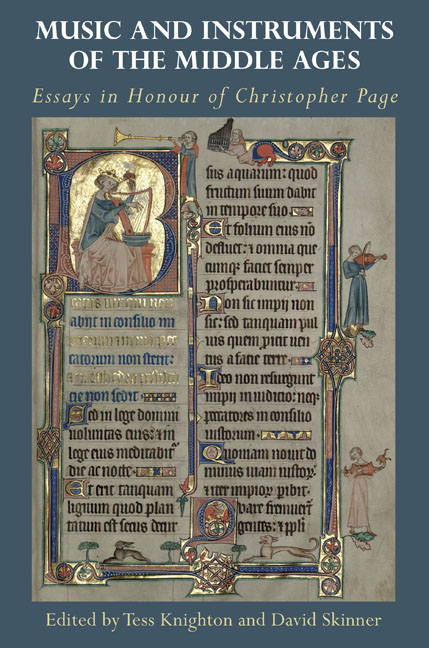Book contents
- Frontmatter
- Contents
- List of Illustrations
- List of Music Examples
- List of Tables
- List of Contributors
- List of Music Manuscript Sigla
- Acknowledgements
- Introduction
- SONGSTERS AND THEIR REPERTORIES
- CLOSE READINGS
- CREATING POLYPHONY
- MUSIC AS CULTURAL PRACTICE
- Works Cited
- Works by Christopher Page
- Index
- Tabula Gratulatoria
- Studies in Medieval and Renaissance Music
12 - In Search of Medieval Music in Non-Western Countries
Published online by Cambridge University Press: 24 November 2020
- Frontmatter
- Contents
- List of Illustrations
- List of Music Examples
- List of Tables
- List of Contributors
- List of Music Manuscript Sigla
- Acknowledgements
- Introduction
- SONGSTERS AND THEIR REPERTORIES
- CLOSE READINGS
- CREATING POLYPHONY
- MUSIC AS CULTURAL PRACTICE
- Works Cited
- Works by Christopher Page
- Index
- Tabula Gratulatoria
- Studies in Medieval and Renaissance Music
Summary
At the beginning of the last century no one really knew what medieval music might have sounded like, or had a clear overview of its sources, let alone the ability to decipher them. After 1900, two groups of German scholars began systematically to explore music of the Middle Ages, but they used completely different methods. The results of the first group are well-known: they were historical musicologists trained by the great medievalist Friedrich Ludwig (1872–1930). Ludwig came from the nineteenth-century Palestrina revival. He set out to explore medieval polyphony in order to find where his favourite composers –Palestrina, Orlando di Lasso and Heinrich Schütz – came from. First a professor in Strasbourg, then, after World War I, in Göttingen, he published his Repertorium organorum recentioris et motetorum vetustissimi stili in 1910; to this day, over a century later, it is still the most authoritative catalogue of, and book on, thirteenth-century organa and motets. He gave the first detailed account of modal notation, listed all concordances in the thirteenth-century repertory, ordered them chronologically, and tried to establish which version was the original and which a copy.
Ludwig was able to identify isorhythm and published three volumes of the works of Guillaume de Machaut. The fourth volume, of Machaut's Mass of Notre Dame, was edited by his student Heinrich Besseler (1900–69) from Ludwig's notes in 1954. In addition, in 1924 Ludwig published a synthesis of all of his previous work in Guido Adler's Handbuch der Musikgeschichte (updated in 1929 and reprinted in 1961). Finally, his papers – which are now kept at Niedersächsische Staats- und Landesbibliothek in Göttingen – include diplomatic and modern transcriptions of most known manuscripts of the thirteenth through fifteenth centuries.
Why did Ludwig publish so little material from his Nachlass? At the beginning of his career he did not believe that it would be worthwhile to publish transcriptions of these pieces; he studied them mainly in order to understand how the history of polyphony came about. All this changed in the 1920s. The closely related German youth movements Wandervogel and Jugendmusik- and Singbewegung all shared a passionate interest in the Middle Ages; they reconstructed the medieval castle Burg Ludwigstein, roughly located between Göttingen and Kassel, went on long hikes, and were eager to sing early music and folk music.
- Type
- Chapter
- Information
- Music and Instruments of the Middle AgesEssays in Honour of Christopher Page, pp. 325 - 344Publisher: Boydell & BrewerPrint publication year: 2020

